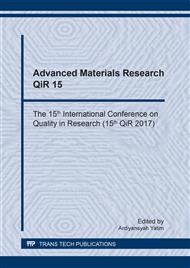[1]
L. Ferreira, J. de Brito and N. Saikia, , Influence of curing conditions on the mechanical performance of concrete containing recycled plastic aggregate. Construction and Building Materials 36,pp.196-204 (2012).
DOI: 10.1016/j.conbuildmat.2012.02.098
Google Scholar
[2]
Y.W. Choi, D.J. Moon, Y.J. Kim and M. Lachemi, Characteristics of mortar and concrete containing fine aggregate manufactured from recycled waste polyethylene terephthalate bottles. Constr Build Mater 23, 2829–35 (2009).
DOI: 10.1016/j.conbuildmat.2009.02.036
Google Scholar
[3]
S.C. Kou, G. Lee, C.S. Poon and W.L. Lai, Properties of lightweight aggregate concrete prepared with PVC granules derived from scraped PVC pipes. Waste Manage, 29,621–8 (2009).
DOI: 10.1016/j.wasman.2008.06.014
Google Scholar
[4]
M. Frigione,, Recycling of PET bottles as fine aggregate in concrete. Waste Management xxx (2010).
DOI: 10.1016/j.wasman.2010.01.030
Google Scholar
[5]
A.M. Mustafa Al Bakri, S.M. Tamizi, A.R. Rafiza and Y. Zarina, Investigation of HDPE Plastic Waste Aggregate On The Properties Of Concrete. Journal of Asian Scientific Research, 1(7), 340-345 (2011).
Google Scholar
[6]
G. Pamudji, H. Purnomo, I. Katili and I. Imran, The use of plastics waste as coarse aggregates for moderate strength concrete. Proceeding the 6th Civil Engineering Conference in Asia Region: Embracing the Future through Sustainability, Jakarta: ISBN 978-602-8605 (2013).
Google Scholar
[7]
M. Satim,, G. Pamudji and H. Purnomo, Effect of Plastic Aggregate coated with Sand to the Compressive Strength of Concrete. Proceedings Sriwijaya International Conference on Engineering, Science & Technology (SICEST), Bangka Island Indonesia, ISBN 979-587-621-1 ., (2016).
Google Scholar
[8]
H. Purnomo, G. Pamudji and M. Satim, Influence of uncoated and coated plastic waste coarse aggregates to concrete compressive strength, MATEC Web of Conference 101 (2017).
DOI: 10.1051/matecconf/201710101016
Google Scholar
[9]
Y.W. Choi, D.J. Moon, J.S. Chumg and S.K. Cho, Effects of Waste PET Bottles Aggregate on The Properties of Concrete. Cement and Concrete Research 35,p.776–781 (2005).
DOI: 10.1016/j.cemconres.2004.05.014
Google Scholar
[10]
K. Hung Mo, U.J. Alengaram, P. Visintin, S.H. Goh and M.Z. Jumaat, Influence of lightweight aggregate on the bond properties of concrete with various strength grades, Construction and Building Materials 84, p.377–386 (2015).
DOI: 10.1016/j.conbuildmat.2015.03.040
Google Scholar
[11]
M. Krizma, J. Petrzala and M. Kovakovic, Deformation characteristics of concrete elements with content of plastic aggregate, Procedia Engineering 65, pp.25-32 (2013).
DOI: 10.1016/j.proeng.2013.09.006
Google Scholar
[12]
K.M.A. Hossain, Bond characteristics of plain and deformed bars in lightweightpumice concrete. Construction and Building Materials 22,1491–1499 (2008).
DOI: 10.1016/j.conbuildmat.2007.03.025
Google Scholar
[13]
J.A. Bogas, M.G. Gomes and S. Real, Bonding of steel reinforcement in structural expanded clay lightweight aggregate concrete: The influence of failure mechanism and concrete composition. Construction and Building Materials 65, p.350–359 (2014).
DOI: 10.1016/j.conbuildmat.2014.04.122
Google Scholar
[14]
Y. Malewar, S. Saleem and A. Titiksh, Gap Grading of Aggregates & Its Effect on The Inherent Properties of Concrete. Journal of Ceramics and Concrete Sciences Volume 2 Issue 1, pp.1-9 (2017).
Google Scholar


